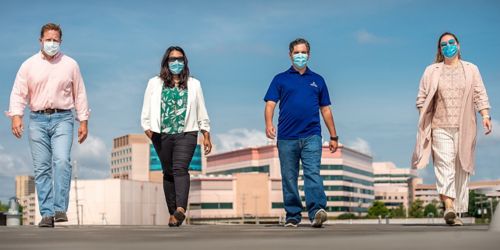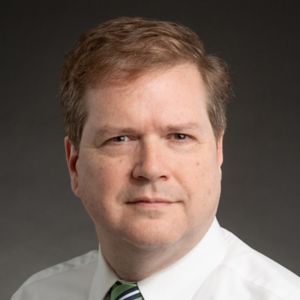St. Jude Family of Websites
Explore our cutting edge research, world-class patient care, career opportunities and more.
St. Jude Children's Research Hospital Home

- Fundraising
St. Jude Family of Websites
Explore our cutting edge research, world-class patient care, career opportunities and more.
St. Jude Children's Research Hospital Home

- Fundraising
Staff scientists in core research facilities accelerate and broaden biomedical discovery

The new Shared Resource Center at St. Jude will house many institutional shared facilities that accelerate discovery.
The new Shared Resource Center (SRC) will be the first building at St. Jude Children’s Research Hospital dedicated entirely to core laboratories and the staff scientists who keep them running. Located east of the future Advanced Research Center, the 30,000 square-foot facility is the new home of 13 of the 21 institutional shared facilities that accelerate and broaden scientific discoveries at St. Jude.
Twelve of these institutional services are moving or partially moving to the SRC from other campus locations. Two other labs are new: the Center for Modeling Pediatric Diseases and the planned Center for High Content Screening. In addition, the SRC will be the new home for the Compound Management and Formulation center from the Department of Chemical Biology and Therapeutics.
These labs were selected for the move because of their related research themes, similar technologies, and the need for more space. Chris Calabrese, PhD, director of Basic Science Programs, explains how scientists from previously isolated core labs may benefit from a more collaborative environment in the new space.
“Developing this suite of resources in a single location will allow for the seamless exchange of technical expertise, enhancement of operational efficiencies and, importantly, free up laboratory space for the recruitment of research faculty,” Calabrese said. “One lab may be sequencing nucleic acids while another is looking at protein sequences, but they are ultimately using complementary tools to improve our understanding of the biology and help answer the same scientific questions.”
Core labs offer more support, less risk for academic departments
Many universities and research hospitals operate shared resources and core facilities to make available advanced technology to academic and clinical investigators. Such facilities began to appear on research campuses a generation ago, particularly as DNA sequencing and bioinformatics services became more accessible.
Core labs are highly specialized and often named after the equipment or techniques hosted there. Faculty in academic departments request and pay for experiments, assays or computation from resource labs instead of purchasing expensive equipment and running the experiments on their own.
Thanks to the generosity of countless donors, the shared resources and core facilities at St. Jude are remarkable in terms of funding, advanced technology, and world-class talent.
The scientists of specialization
Core labs give faculty researchers access to advanced—and speedy—scientific instruments, but their long-term value lies in the caliber of scientific talent operating the services and designing experiments. Approximately 120 staff researchers and technologists work in the institutional cores, many of whom hold PhDs, while nearly 40 more work in the shared departmental labs.
“While the shared resources have changed over my 20 years at St Jude, these scientists’ commitment to advancing institutional research has been unwavering,” said virologist Richard Webby, PhD, faculty member in the Infectious Diseases department and director of the World Health Organization Collaborating Center for Studies on the Ecology of Influenza in Animals at St. Jude.
While the complexity and cost of first-rate scientific technology continue to expand, core lab scientists serve as experts in their areas and can perform experiments more efficiently than departmental scientists can do in their labs. In this way, principal investigators and their staff run less risk of failed analysis while trying an unfamiliar technique that has already been mastered by a core lab scientist.
“Researchers at other institutions may have the same instrumentation,” said Aaron Pitre, PhD, staff scientist in the Light Microscopy Core Facility, “but they may not have access to a backbone of imaging scientists. We can take that cutting-edge, cool science and make it a little bit cooler and, hopefully, get more data out of it at a faster pace.”
“These labs provide cutting edge technologies, but more importantly, they are staffed by an invaluable cadre of expert scientists who lead their fields,” Webby said. “These individuals ensure that we stay current and bring the most relevant technologies to our research.”
Careers driven by expertise and enthusiasm
What are the differences between resource core scientists and the faculty, staff and postdocs working in academic department labs? There are more similarities than differences between the two groups, including education and experience. However, many resource core scientists display particular enthusiasm for new technology, helpfulness with a wide variety of scientific questions, adaptability in working with different personalities and a high capacity for multitasking.
“You may come to a tipping point in your career where you decide if you want to follow the academic faculty route or other opportunities,” said Calabrese, who opted for such an opportunity himself in 2005. “Scientists who gravitate toward the cores appreciate the structure of the job and the opportunity to learn high technology, high acuity work.”
Gang Wu, PhD, originally came to St. Jude in 2010 as a staff scientist on the monumental Pediatric Cancer Genome Project (PCGP). Even after his recent faculty appointment and being named director of the new Center for Applied Bioinformatics (CAB), Wu hasn’t lost his love of learning and bench work.
“The beauty of working in a shared resource is that I will never be out of date on new technology,” Wu said, “and I can still have a first-hand experience with the real data, which is a lot of fun.”
Staff scientists focus on the science
Evadnie Rampersaud, PhD, MSPH, a staff scientist in the Center for Applied Bioinformatics, helps investigators apply data science to their research—from planning experiments to analyzing existing data. Most of the lab’s work involves the application of computational methods in genetics, genomics, transcriptomics and epigenetics. Rampersaud heads the team that provides genetics support.
Since she started at St. Jude in 2015, Rampersaud has helped jumpstart three whole genome sequencing projects focused on sickle cell disease, Amyotrophic Lateral Sclerosis and familial studies of cancer.
“My role in CAB is to help our staff scientists produce quality results that can benefit investigators and help them to secure more grants. My passion is to explore new statistical and bioinformatics methods that can help inspire their research goals. I can accomplish this under the shared resource research umbrella.”
Emily Walker, with the Affymetrix and Illumina Microarray Analysis lab, is one of the dozens of staff scientists moving into the SRC. While she is an expert at analyzing genetic changes across millions of cells at a time, Walker also has a knack for slowing down time. An academic research lab at St. Jude had a massive trove of cell samples for Walker’s lab to physically and digitally process as part of a National Institutes of Health (NIH) grant proposal—a full year’s worth of work.
But the proposal was due in four months.
Walker’s ability to meet such an alarming deadline explains, in part, why she was honored during the 2019 St. Jude Research Staff of the Year program.
“Emily's dedication and her ability to do her job at such a high level, has brought success for principal investigators here because the data she generates is just dead-on reliable,” said Geoff Neale, PhD, director of the Hartwell Center, which houses Walker’s lab and five other high-throughput biotechnology resources.
The staff of life
Pitre, Rampersaud, Walker and scores of other staff scientists at St. Jude are advancing cures for pediatric cancer and other catastrophic childhood diseases. They accomplish this by piloting and interpreting the techniques and technologies that facilitate high-quality data gathering, which ultimately lead to new discoveries.
Shared Resource Center labs and services
Hartwell Center for Biotechnology:
- Sanger DNA Sequencing
- Genome Sequencing
- Genotyping Analysis
- Macromolecular Synthesis
- Affymetrix and Illumina Microarray Analysis
- Functional Genomics
Protein Production Preclinical Pharmacokinetics Proteomics and Metabolomics Transgenic Core/ES Cell Lab St Jude Biorepository’s extraction lab Center for Modeling Human Pediatric Diseases (new) High Content Screening Lab (planned) Laboratory Services SRC annex Compound Management and Formulation (Chemical Biology and Therapeutics)
Learn about individual Shared Resources and Core Facilities at St. Jude.






